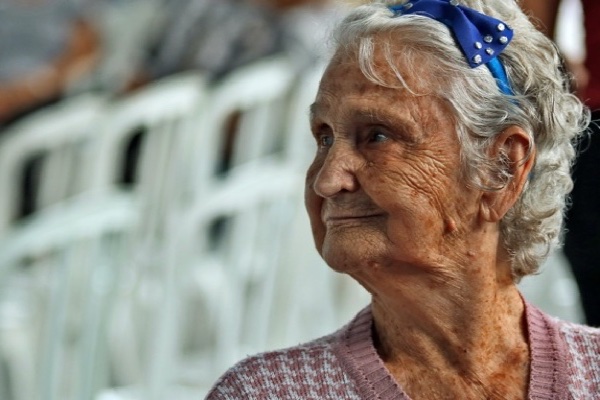Osteoporosis, a silent disease

Like high blood pressure, osteoporosis, or porous bone, is a silent disease that can have devastating effects. A disease that can result in serious fractures, osteoporosis is a major public health threat for 44 million Americans, 68 percent of whom are women. In the U.S. today, 10 million people already have osteoporosis and 34 million more have low bone mass, placing them at increased risk for this disease.
Dr. Shailaja Reddy, an internal medicine physician at Pacific Medical Center’s Renton clinic, said, “It’s a major problem. The first indicator you get is a fracture and if you are age 75 or 80 and you have a hip fracture it may take months to recover from it,” she said.
The message Dr. Reddy drives home with her patients is one of awareness and prevention. “Get your calcium and exercise, even if you’re in your forties. If you do this consistently from a younger age it will help you down the road,” she said. Paying attention to Dr. Reddy’s message makes sense; osteoporosis is responsible for 1.5 million fractures annually, including 300,000 hip fractures.
As with many illnesses there are certain risk factors that may indicate whether a person will develop the disease. The chance of developing osteoporosis is greater for women because they have less bone tissue and lose bone faster than men because of the changes that occur with menopause.
While many people may think of osteoporosis as a woman’s disease, men can be at risk, too, Dr. Reddy said. “Anyone who is slim and weighs less than 127 pounds is at risk,” she said. Smoking cigarettes and drinking excess alcohol (more than three glasses daily) are also factors. In addition, the older you are, the greater your risk of osteoporosis.
While there is no gene that’s been found to be associated with the disease there is a family tendency toward it. “If you have a first degree relative with osteoporosis you are at high risk,” warned Dr. Reddy.
Getting enough calcium in the diet is key to prevention, she said. Women who are past menopause should take 1200 mg. daily of calcium in divided doses.
“That’s really important. If you take all 1200 mgs at once your body can’t absorb it all,” she said, adding that it’s important to take between 600 and 800 international units of Vitamin D daily. Without the Vitamin D calcium can’t be absorbed. Dr. Reddy noted that because of the many gray days in the Pacific Northwest, vitamin supplements may be the answer because sunlight is required to naturally produce Vitamin D.
The type of exercise needed to prevent osteoporosis is weight-bearing exercise such as walking, jogging, weight training, hiking or yoga. Being sedentary and not taking calcium raises the risk of bone loss. So does long-term use of glucocorticoids.
Want to know the status of your bone health? Your best bet is a bone mineral density test to identify osteoporosis, determine your risk for fractures and measure your response to osteoporosis treatment. The most widely recognized bone mineral density test is a DXA test, a painless test similar to an X-ray but with much less exposure to radiation.
Dr. Reddy said that Fosamax, Actonel and Boniva are the class of drugs that have been shown to be most effective. Fosamax and Actonel are taken weekly while Boniva is a newer medication that is taken monthly. Dr. Reddy advises her patients to take one of the two weekly medications first because they have been proven over many years to be both safe and effective. “Other medications are also available for treatment- be sure to discuss with your doctor what will work best for you,” said Dr. Reddy.
Find the Right Primary Care Doctor for You
 Everyone needs a primary care doctor—the one who conducts your physicals, the one you call when you twist your ankle, get stung by a bee, or eat something funny. Some doctors treat entire families; others see only children or only adults. Which type of doctor best suits you and your family? Let’s take a look at four types of primary care physicians.
Everyone needs a primary care doctor—the one who conducts your physicals, the one you call when you twist your ankle, get stung by a bee, or eat something funny. Some doctors treat entire families; others see only children or only adults. Which type of doctor best suits you and your family? Let’s take a look at four types of primary care physicians.
Family Medicine (also known as Family Practice) – Care for all individuals
At the heart of this specialty is the patient-physician relationship. Family Medicine practitioners cover all areas of general health care, including pediatric and adolescent health, women’s health and gynecology, men’s health and aging issues.
Internal Medicine (also known as “Internists”) – Care for adults
Internal Medicine practitioners are trained to deal with any medical issue an adult patient may have, from preventive care and common disorders to rare or chronic diseases. Internists see a wide variety of patients ranging from highly athletic individuals to people with diabetes, hypertension, cardiovascular disease, cancer, and kidney disease. They help all their patients work toward achieving optimal physical and mental health. Medical systems can be difficult for patients to navigate through, especially if they have complex medical problems. Internists work with multiple specialists and other care providers to help patients achieve a sense of comprehensive and coordinated care.
Pediatrics – Care for children
Pediatrics is concerned with the prevention, diagnosis, and treatment of diseases of infants, children, adolescents, and young adults. Because young patients are rapidly growing and changing, pediatricians must communicate with caregivers to ensure they understand as much as possible about their children’s growth, development, and overall picture of health.
Geriatric Medicine – Care for adults of advanced age
Geriatric Medicine is concerned with the prevention, diagnosis, and treatment of disorders that occur in older people. Today, the number of people aged 65 and older is larger than ever before, and those aged 85 and older constitute the fastest growing segment of the population. Geriatricians recognize that aging is not an illness; rather, it is a time where quality of life and functional ability can be maintained with proper care, and health and happiness are encouraged.
Creating a healthy lifestyle for your family
 Many parents ask me for advice on how to keep their children healthy. For most parents and kids, hearing “diet and exercise” is not only intimidating but also overwhelming. They don’t know how and where to start. To help demystify those words of advice that they often hear, I suggest simple lifestyle changes. Parents should play a proactive role in setting up a positive environment in which their children can succeed. Small, consistent changes in eating habits and lifestyle are very powerful. They have long-lasting effects on a child’s future habits.
Many parents ask me for advice on how to keep their children healthy. For most parents and kids, hearing “diet and exercise” is not only intimidating but also overwhelming. They don’t know how and where to start. To help demystify those words of advice that they often hear, I suggest simple lifestyle changes. Parents should play a proactive role in setting up a positive environment in which their children can succeed. Small, consistent changes in eating habits and lifestyle are very powerful. They have long-lasting effects on a child’s future habits.
Here are 10 simple steps parents can take to set their family on the road to a healthy lifestyle:
- Stock the house with healthy snacks. When a child wants a cookie, it’s easier to say no if it is not available. Stock up on fresh fruits, dried fruits and nuts. Cut and package fruit and nuts in advance so they are ready for your kids to grab when they are hungry.
- Plan meals. Use the weekend to plan meals for the week ahead. Involve your family in the planning. This avoids fast-food outings during a busy week. Make enough for leftovers to take to school or to the office.
- Eat mindfully. Eat as a family at the dinner table at least five times a week without the distractions of the TV, computer or cell phone. Enjoy your meals as a family. Kids eat slower and stop when they are full when they eat without distractions. Avoid eating on the run, in the car, on the couch or over the sink.
- Eat more fruits and vegetables. Plan on serving your kids a colorful salad or vegetable dish at each meal. Kids respond to exciting, colorful food!
- Eat high-fiber carbohydrates. Choose whole-grain bread, whole-wheat pasta, brown rice, yams or sweet potatoes.
- Eat breakfast. Encouraging kids to eat a healthy breakfast keeps them from overeating later in the day or eating an unhealthy lunch at school. They also pay better attention in class.
- Drink water. Avoid sugary drinks such as sodas, juices and energy drinks. Even diet drinks can increase cravings for other sugary food products. In addition, kids perceive thirst as hunger. Hunger subsides when they are well hydrated.
- Control portions. Measure your kids’ portions instead of letting them serve themselves. Encourage them to eat slowly by having a family conversation at the dinner table. Wait 20 minutes before giving another portion; it takes awhile for the stomach to tell the brain that it is full. Most of the time, kids don’t even need that second portion if they just wait.
- Move. It’s important for kids to be active. They can be part of an after-school sports group. Or the family can take short hikes, walks in the neighborhood or bike rides. Make it fun for the kids to take the stairs instead of the elevator. If the family does watch TV, try to do something active with it like a hula-hoop competition during commercial breaks.
- Be a positive influence. It’s important for kids to know that mom and dad are committed to living a healthy lifestyle. Practice and live the previous steps daily.
It’s easier for kids to live a healthier lifestyle inside and outside the home if they are given the tools and resources that start within the home.
Let’s get healthy – recommendations for healthy eating and living

Parents, did you know that over 30 percent of America’s school-age youngsters are now overweight? Why is that? Food is more plentiful and more convenient than ever before. Fast-food restaurants are everywhere, and portion sizes are becoming huge. And with the invention of TV, the Internet, and labor-saving devices, we just don’t move anymore. Kids used to play outside and be more involved with sports. Now, TV, video games, and the Internet have made everyone more sedentary.
Being overweight can contribute to physical problems such as high blood pressure, diabetes and heart disease even in young children. Being overweight also limits a child’s athletic abilities and impairs self-esteem. Here is a summary of recommendations made by the American Academy of Pediatrics and the American Heart Association for healthy living and eating:
- Eat at least five vegetables and fruits every day.
- Drink water or unsweetened beverages in place of sweetened beverages. Sweetened beverages include juices, soda and sports drinks. Juice is not healthy as many people think.
- Use vegetable oil, canola, corn oil or safflower oil instead of solid fats such as butter and lard when cooking.
- Eat more beans and tofu in place of meats.
- Use lean meats. Remove the skin from chicken before cooking or eating.
- Eat whole-grain breads and cereals instead of refined products.
- Serve fish as an entrée at least twice a week. Serve fish broiled or baked.
- Use nonfat or low-fat milk and dairy products daily.
- Drink six to eight glasses of water each day.
- Remember portion size when serving your kids. The size of the meat should be about the size of the palm of the child’s hand.
- Perform 60 minutes of moderate to vigorous play or physical activity daily. This includes walking, riding a bike or playing outside.
- Limit TV and video games to less than two hours each day.
Sound hard? Not if you incorporate these routines into your daily living and everyone in your family participates. Remember, as parents, you determine what you buy in the grocery store and what you serve to your children. Do your best to keep them healthy.
Countering childhood obesity with healthy habits
As Americans, we are proud to be first in so many things. Unfortu nately, we are also first in something that shouldn’t make us proud—childhood obesity. In the United States, 17% of children and adolescents between the ages of 2 and 19 are obese. An overweight child faces added health risks. Children and adolescents who are obese are more prone to high blood pressure, heart disease, type 2 diabetes, asthma and sleep apnea, as well as low self-esteem, depression and social discrimination.
nately, we are also first in something that shouldn’t make us proud—childhood obesity. In the United States, 17% of children and adolescents between the ages of 2 and 19 are obese. An overweight child faces added health risks. Children and adolescents who are obese are more prone to high blood pressure, heart disease, type 2 diabetes, asthma and sleep apnea, as well as low self-esteem, depression and social discrimination.
Parents can help their kids create a lifetime of healthy eating and physical activity by being positive role models. If parents don’t exercise and eat healthy, how can anyone expect their children to lead a healthy lifestyle? At home, you can help your children by practicing these healthy eating habits:
- Keep portion sizes healthy. Over the years, the idea of a healthy portion has ballooned! At home, try serving meals on smaller plates. Encourage your children to have a little bit of everything, and to make second servings smaller than first servings.
- Create a balanced meal. Imagine the dinner plate divided in quarters. For lunch and dinner, your child’s plate should be one-half vegetables, one-fourth protein and one-fourth starch. Serve fruit for dessert.
- Ensure variety. Provide plenty of vegetables, fruits, and whole-grain products. Choose lean meats, poultry, fish, lentils, and beans for protein.
- Decrease sweet beverages. Sodas and drinks containing fruit juice offer lots of calories and little nutritional value. They also can fill your child, who may then not want to eat a healthy meal.
- Don’t use food as a reward. Avoid using food as a reward for a job well done. Instead, offer your kids a small prize, playing their favorite board game or going to their favorite park.
- Don’t eat and watch TV. Turning off the television while eating is an important habit to instill in children. Studies show that food consumption increases while watching television.
When dining out, you and your children can make healthy choices:
- Down-size your entrée. Share a main course with a family member, or choose an appetizer, broth-based soup or side dish instead of a main course.
- Avoid buffets. Avoid situations where overeating can easily occur, such as buffets. When people go to “all you can eat buffets,” they tend to eat more than they should.
- Make smart fast-food choices. Fast-food restaurants can be hard to avoid with our hectic schedules, but if you need to use one, help your child choose something that is grilled, steamed or baked instead of fried. Avoid pre-set meals that include fries and soda pop.
Finally, make exercise fun and frequent. Encourage your child to take part in team sports and individual pursuits such as biking or rock collecting. Instead of playing electronic games, get the family outside to walk to the library or to play a quick game of tag or jump-rope. Demonstrate healthy choices by parking the car far from a store’s door or taking the stairs instead of an elevator.
The overall goal for the treatment of childhood obesity should be to make exercise and healthy eating habits a permanent way of life. Obese children and adolescents are more likely to be obese as adults, so the sooner parents can instill routine exercise and healthy eating, the better. When making changes in the way your child eats and exercises, it is imperative to be supportive of them. Tell your child that he or she is important, special and loved. By making small changes every day, big changes will occur over time.
Doctor uses office to share reading
 When a Renton doctor decided she wanted to give more to the community, encouraging families to read together seemed like the natural choice.
When a Renton doctor decided she wanted to give more to the community, encouraging families to read together seemed like the natural choice.
“There’s a large group of people who don’t realize that it’s important to read to your 6-month-old,” said Sonja Maddox, a family physician at Pacific Medical Center.
Five of the clinic’s family doctors give books to kids ages 6 months to 5 years a new book during their normal checkup.
The program is organized through Reach Out and Read, a national non-profit that encourages hospitals to do the same thing.
They’ve participated in the program for two years, giving out 150 books in the past year.
“The younger kids will put the book in their mouth,” she said, explaining this reaction often makes parents wonder how it could even benefit children that young.
“It’s about spending time with and getting kids excited about books,” she said.
Early reading helps with language development, increasing chances of school success.
“Kids who are read to are more school ready and more prepared to like learning,” Maddox said.
About 16 percent of children never get read to, and about 23 percent get read to only once or twice a week, according to Reach Out and Read. It’s often families living in poverty that don’t have access to new books and libraries.
Maddox raised enough funds through grants to support the program without the assistance from the national organization, she said.
Being read to as a child, it seemed only natural to read to her 2-year-old daughter.
“It’s something she loves to everyday,” Maddox said, adding with a laugh, “She demands it.”
Maddox is a local, growing up in South King County and studying medicine at the University of Washington. She’s been practicing medicine for 7 years.
When she was studying for her undergraduate degree, she had a friend in college that had a serious tumor, she said. “Her doctors were helping her.”
Realizing that she too wanted to help people, she decided to go into medicine.
“I grew up knowing that I could be whatever I wanted to be,” she said.
A young doctor, Maddox has been at Pacific Medical for four years, but she loves the amount of charity care the center offers.
“I love the vision and the variety ofpeople I help take care of,” she said. “I really like my patients.”
Making Summer Reading Fun for Kids
 Our lazy, hazy, crazy days of summer seem a little heavy on the “crazy” these days: T-ball practice, swim team, gym class, day camp, play dates … the list goes on. When did “summer” become code for “hectic”?
Our lazy, hazy, crazy days of summer seem a little heavy on the “crazy” these days: T-ball practice, swim team, gym class, day camp, play dates … the list goes on. When did “summer” become code for “hectic”?
Now that summer is in full bloom, it might just be the perfect time to dial things down, curl up beneath a shady tree and get utterly lost in a mind-nurturing book.
Wish you could do that?
You can. Pick up your New York Times best seller or your favorite classic from English Lit, pack up some great reads for the kids, find a cozy outdoor spot and read away — together.
Mind the gap
That’s one way to support your child’s summertime reading, an activity that educators consider crucial to learning and school achievement. When kids don’t read during the summer months — the experts call that “summer reading setback” — they often fall behind with their reading when they return to school in the fall, says Amy Twito, youth services program manager at the Seattle Public Library.
Studies show that low-income and minority students experience more summer learning and reading loss than their middle-class and white classmates, she says. “Reading is the only activity that is consistently related to summer learning,” Twito says.
“When you’re out of school, it’s good to be around a print and information environment,” says Kate Pappas, children’s services librarian at the Seattle Public Library’s Rainier Beach branch. Libraries, she points out, provide access to a world of books and information that most people don’t have at home. “It’s great for kids to come to the library and sample all the enriching materials that will keep their minds working,” says Pappas.
Let them choose
But reading — especially the summer-vacation kind — should be fun. After all, we want children to enjoy books and view reading as a joy, not a chore.
That’s why kids should be the “deciders” when it comes to reading materials. “You should always let kids choose, especially during the summer,” says Christy McDanold, owner of Secret Garden Books in Ballard. “Reading helps maintain skills, but if you remove the pleasure, that’s not going to happen.”
Summer is not the time to worry about challenging your kids’ reading level, McDanold says. “The books shouldn’t be too hard. Kids like to select what they know.” Choosing books they’re familiar with from school is fine — and so is perusing the same book over and over. “When your child does that, she’s practicing — and she’s reading,” she says.
How can parents help their children find the right reading fit? “If your kids try to read a page and make five or six errors, the book might be too hard,” says McDanold. “If they read with no errors, it might be too easy.”
If they can’t read at all — say you’ve got babies or preschoolers — then read to them. “Even if a child’s attention span is a minute, point out pictures, name things in books and make this a part of their everyday routine,” says Dr. Sonja Maddox, a Renton family medicine practitioner who’s involved in the national Reach Out and Read program. The program promotes early literacy by working with health-care providers to distribute new books to children.
Reading is fundamental
As they say, “You can lead a child to a good book, but you can’t make him read.”
OK, that’s not what they say exactly, but you get the point. Reading Is Fundamental (RIF), a national nonprofit literacy organization, suggests parents can help foster summer reading habits by reading to their kids 30 minutes each day; by helping their kids get library cards; visiting the library with them; keeping children’s books around the house; setting up reading areas at home; and giving children writing materials.
RIF also recommends parents begin a tradition of “summer evening storytelling,” an outdoor activity that involves the family: Each person comes up with a story idea and takes turns telling stories.
Parental participation sends a positive message, says McDanold. “If reading is valued and considered fun, that will come through.” Family members should take books on summer vacations and talk about what they’re reading, she says.
Another summer reading travel idea? Play books on tape during those late-summer road trips. “Find classic kids’ books that adults enjoy — Harry Potter comes to mind — and poetry by Jack Prelutsky and Shel Silverstein,” says McDanold.
Audio books can be magical, she says. “It’s not just an escape by yourself; you share the experience and have that under your belt forever. It will be part of your family lore.”
Linda Morgan, ParentMap associate editor, is the author of the forthcoming book Beyond Smart: Boosting Your Child’s Academic, Social, and Emotional Potential.
The ABCs of boosting summer reading
Access to books. It’s critical that kids have access to a wide variety of books over the summer months, but we know that access alone doesn’t make a strong impact.
Books that match readers’ ability levels and interests. For young people’s reading skills to improve, they need to read books that align with their own reading levels. Reading books that are too easy or too hard won’t help.
Comprehension, as monitored and guided by an adult, teacher or parent. The most important piece to making summer reading effective is the help of an adult who can ask questions and guide kids to better understand what they are reading.
Source: National Center for Summer Learning at Johns Hopkins University
Great summer reads for kids
Following is a list of great reads for kids, compiled and reviewed by Maria Pontillas, youth services librarian at the Tacoma Public Library.
Summer reading picks for elementary school students:
A Couple of Boys Have the Best Week Ever by Marla Frazee. Two young boys, Eamon and James, spend an action-packed weekend at Eamon’s grandparents’ beach cottage in this lively picture book.
The Foggy, Foggy Forest by Nick Sharratt. What’s going on in the forest? Opaque pages keep kids guessing as famous storybook characters frolic between the pages of this picture book.
The Doghouse by Jan Thomas. When the ball accidentally goes into the doghouse, Mouse sends his friends in, one by one, to retrieve it. But they don’t come out. Will Mouse be next? A silly picture book just right for sharing.
Savvy by Ingrid Law. Mibs Beaumont’s 13th birthday will be special. Thirteen is the year that the Beaumont kids get their savvy — or special talent. One brother creates electricity, another commands hurricanes. What will Mibs’ savvy be?
The Maze of Bones by Rick Riordan. Siblings Amy and Dan are heartbroken when their grandmother dies, but at her funeral they are invited to enter a game that promises worldwide domination to the winner. They embark on a worldwide challenge to chase down the 39 clues and defend the family name. First book in the “39 Clues” series.
The Bill Martin Jr. Big Book of Poetry, edited by Bill Martin Jr. This collection of favorite poems for kids features illustrations from several famous children’s illustrators.
Summer reading for tweens:
The Underneath by Kathi Appelt. Part legend, part love story, part animal tale, The Underneath is the unforgettable story of an old dog named Ranger and three abandoned cats that live under a rickety house in the swamp. When Ranger’s cruel owner separates them, the animals struggle to be reunited.
Invasion of the Road Weenies by David Lubar. Like The Twilight Zone for kids, this book is filled with creepy, funny and just plain weird short stories.
Waiting for Normal by Leslie Connor. Twelve-year-old Addie just wants a normal life. Her mother is busy with new business ideas and boyfriends. Her mom’s ex-husband, Dwight, has his own family to take care of. Who has time for Addie?
The Mysterious Benedict Society by Trenton Lee Stewart. Answering an ad, talented orphan Reynie Muldoon joins three other special children to form the Mysterious Benedict Society, whereupon they are sent on a special mission to infiltrate the Learning Institute for the Very Enlightened. A Lemony Snicket–inspired adventure.
Middle School Is Worse Than Meatloaf by Jennifer Holm. Told through diary entries, notes, class schedules, and other “stuff,” seventh-grader Ginny Davis is having a hard time adjusting to middle school. Her former best friend got the lead in the ballet, Brian Bukvic keeps bothering her, and her juvenile delinquent brother may have pulled his last prank ever.
What the World Eats by Peter Menzel and Faith D’Alusio. Ever wonder what families in Egypt eat? Flip through this book, which features photos and facts about kitchens, cooking and food from all over the world.
Summer reading faves for teens:
What I Saw and How I Lied by Judy Blundell. When 16-year-old Evie’s stepdad, Joe, returns from World War II, life goes back to normal, but one day a mysterious phone call sends the family to Florida. There, a handsome ex-soldier catches Evie’s eye, but he seems to make Joe nervous. Sometimes things are not what they seem.
The Hunger Games by Suzanne Collins. If you like watching Survivor, you’ll love The Hunger Games! Sixteen-year-old Katniss gets a chance to save her family from a life of poverty when she is randomly chosen to participate in the Hunger Games, a competition that pits kids against each other in a fight to the death.
Little Brother by Cory Doctorow. When terrorists blow up a bridge in San Francisco, 17-year-old Marcus and his friends are kidnapped and cruelly questioned by the police as suspects. Now the government is watching their every move.









